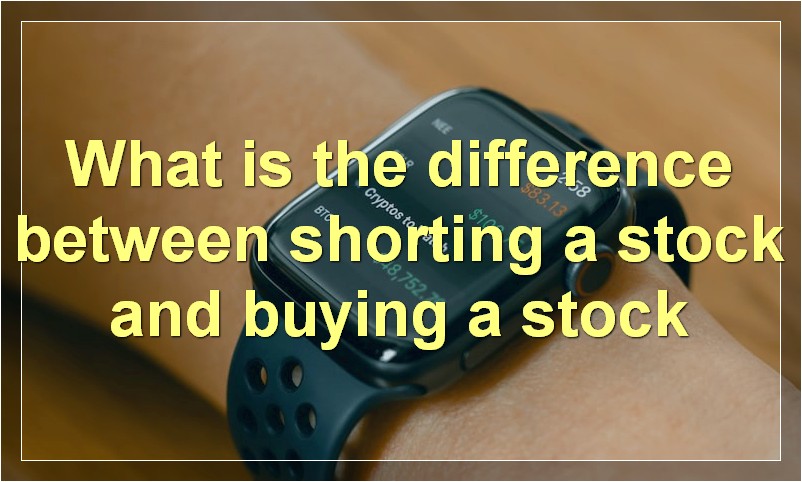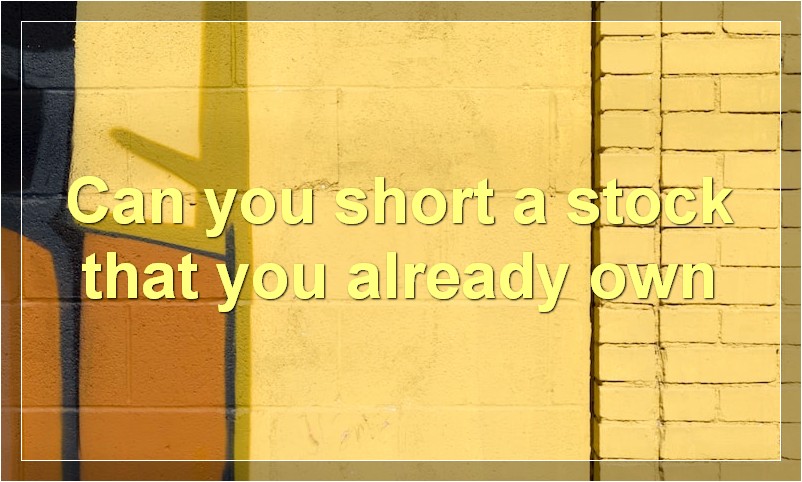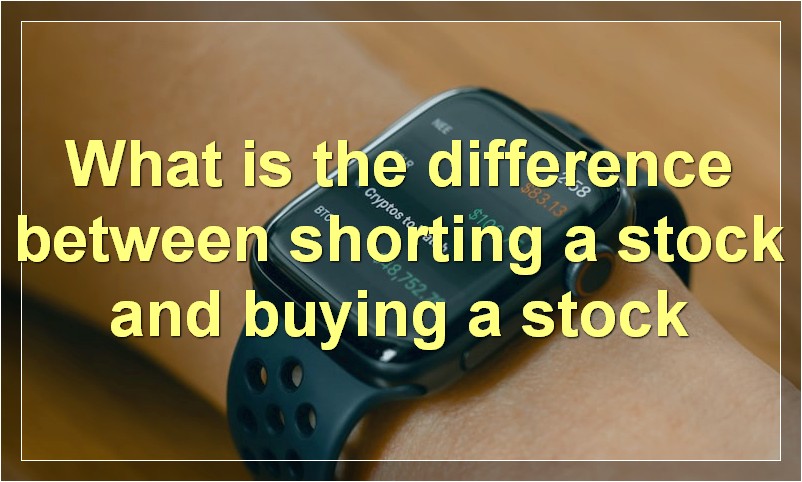Many people believe that shorting stocks is a risky investment strategy, but with the right research and knowledge, it can be a profitable endeavor.
What is short a stock meaning
If you’re new to investing, you may have heard the term “shorting a stock” and wondered what it meant. Shorting a stock is when an investor borrows shares of a stock that they believe will decrease in value, and then sells those shares. If the stock does indeed drop in value, the investor can buy it back at a lower price and return the shares to the person they borrowed them from, pocketing the difference as profit.
However, if the stock price goes up instead of down, the investor will have to buy back the shares at a higher price than they sold them for, resulting in a loss. So shorting a stock is a risky proposition, but one that can pay off if done correctly.
What is the difference between shorting a stock and buying a stock

When you short a stock, you borrow shares of the stock from somebody else, sell the stock, and hope the price falls so you can buy it back at a lower price and give the shares back to the person you borrowed them from. Buying a stock is simply purchasing shares of a company with the hopes that the stock will increase in value so you can sell it at a profit.
How do you make money from shorting a stock
In order to make money from shorting a stock, you must first borrow the shares from another investor and then sell them. Once the stock price falls, you will then buy the shares back at a lower price and return them to the original owner. The difference between the price at which you sold the shares and the price at which you bought them back is your profit.
What are the risks of shorting a stock
When you short a stock, you borrow shares of the stock from a broker and sell them. hope the price of the stock falls so you can buy it back at a lower price and give the shares back to the broker. You hope to profit from the difference between the price you sold the stock at and the lower price you bought it back at. Shorting is risky because you can lose a lot of money if the stock price goes up instead of down.
What happens if you are assigned when shorting a stock
If you are assigned when shorting a stock, it means that you must buy the shares of the stock at the current market price and deliver them to the person or institution from whom you borrowed the shares.
Can you short a stock that you already own

If you’re thinking about shorting a stock that you already own, there are a few things you need to consider before making this move. First, it’s important to understand what shorting a stock entails. When you short a stock, you’re essentially borrowing shares of the stock from someone else and selling them in the hopes that the price will go down so you can buy them back at a lower price and return the shares to the person you borrowed them from.
There’s a lot of risk involved in shorting a stock, especially if you’re doing it with shares that you already own. If the price of the stock goes up instead of down, you could end up losing money on the deal. And if the price goes up enough, you could even end up owing money to the person you borrowed the shares from.
That being said, there are also potential rewards to shorting a stock that you already own. If the price does go down, you could make a profit on the difference. And if the price goes down enough, you could even end up making more money than if you had simply held on to your shares and waited for the price to go down.
So, can you short a stock that you already own? It’s possible, but it’s not without its risks. Make sure you understand those risks before making any decisions.
What is the maximum loss possible when shorting a stock
When shorting a stock, the maximum loss possible is equivalent to the price of the stock. For example, if a stock is trading at $100 and you short it, your maximum loss is $100. Shorting a stock is essentially borrowing shares of the stock from somebody else, selling the stock, and then buying it back at a later date to return the shares to the person you borrowed them from. The difference between the price you sold the stock at and the price you bought it back at is your profit or loss.
How do you know when to short a stock
When you short a stock, you borrow shares of the stock from a broker and sell the stock. If the price of the stock goes down, you can buy the stock back at a lower price and give the shares back to the broker. You hope to profit from the difference between the price you sold the stock at and the lower price you bought it back at.
However, if the price of the stock goes up, you will have to buy the stock back at a higher price than you sold it for. This will result in a loss.
You should only short a stock if you are confident that the price will go down. You should have a solid reason for thinking that the price will fall, such as bad news about the company or sector that the stock is in.
If you are not confident that the price will go down, you are better off not shorting the stock.
What are some common strategies for shorting stocks
There are a few common strategies that investors use when shorting stocks. One popular strategy is to wait for a stock to reach its 52-week high, and then sell it short. This strategy is based on the premise that once a stock reaches its 52-week high, it is likely to start going down.
Another common strategy is to wait for a stock to drop below its moving average, and then sell it short. This strategy is based on the premise that once a stock drops below its moving average, it is likely to continue going down.
Finally, some investors simply sell short any stock that they believe is overvalued. This strategy is based on the premise that all stocks will eventually revert back to their intrinsic value, and so selling short any stock that is trading above its intrinsic value will eventually result in a profit.
Are there any tax implications when shorting a stock
When shorting a stock, investors are essentially betting that the stock price will fall in the future. If the stock price does indeed fall, the investor will make a profit. However, if the stock price rises, the investor will incur a loss. There are a few different tax implications to be aware of when shorting a stock.
If an investor shorts a stock and then buys it back to close out the position, this is considered a “wash sale.” Wash sales are not allowed, and the investor will not be able to deduct the loss from their taxes.
Another thing to be aware of is the “short-term gain” or “long-term gain” status of any profits made from shorting a stock. Short-term gains are taxed at the investor’s marginal tax rate, while long-term gains are taxed at a lower rate. To qualify for the long-term gain tax rate, the investor must hold the position for more than one year.
In general, it is best to consult with a tax advisor before shorting a stock to ensure that you are aware of all potential tax implications.

